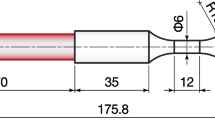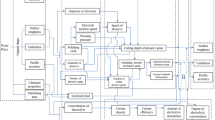Abstract
This study discusses the performance assessment of the continuous burnishing processes following electrochemical finishing using a design, which incorporates a finish-tool that includes an electrode and a nonconductive burnishing-tool. One can expect to make an effective evaluation on the processing features and set up the complete data for processing parameters. In the future, it is also expected to spread a freeform surface finish instead of the conventional hand or machine polishing. In the experiment, a model toy missile is taken as a workpiece. The electrode is used with the continuous and pulsed direct current application. The burnishing-tool uses ceramic material and is connected with the electrode and axial feed. It was found that the finished effect of the finish-tool with convex features is better than mat of the concave features. Pulsing direct current can slightly improve the effect of electrochemical finishing. High rotational speeds produce a better finish for workpieces. This presents an effective and low-cost finishing process that includes the design of a finish-tool, which uses burnishing assistance, and follows electrochemical finishing after traditional machining makes the freeform surface of a workpiece smooth and bright.
Similar content being viewed by others
References
A. M. Hassan and A. M. Maqableh, The effect of initial burnishing parameters on non-ferrous components,Journal of Materials Processing Technology. 102 (2000) 115–121.
A. M. Hassan, The effects of ball- and rollerburnishing on the surface roughness and hardness of some non-ferrous metals,Journal of Materials Pro-cessing Technology. 72 (1997) 385–391.
M. Shirsaru and B. Ahujab, Parametric analysis of combined turning and ball burnishing process,Indian Journal of Engineering & Materials Sciences. 11 (2004)391–396.
J. Wilson, Practice and Theory of Electro- chemical Machining, Wiley-Interscience, New York, NY, (1971)79–161.
A. R., S. J. Mileham and K. J. Harrey and Stout, The Characterization of Electrochemically Machined Surfaces,Wear. 109 (1986) 207–214.
J. Bannard, Effect of Flow on the Dissolution Efficiency of Mild Steel during ECM,Journal of Applied Electrochemistiy. 7 (1977) 261–270.
W. M. Shen, The Study of Polishing of Electric Discharge-Machined Mold With ECM,M.Sc. Thesis, National Yunlin Institute of Techndogy. Taiwan (1995).
S. S. Iskander, I. A. S. Sedahmed, G. H. Mansour, Electropolishing of Brass Alloys in Phosphoric Acid,Surface Technology. 10 (1980) 357–361.
M. Datta and D. Landolt, Electrochemical Machining Under Pulsed Current Conditions,Elector. Acta. 26 (1981) 899–907.
K. R. Rajurkar, Modeling and Monitoring Interelectrode Gap in Pulse Electrochemical Machining,Annals of the C.I.R.P. 44 (1995) 177–180.
L. Cagnon, V, Kirchner, M. Kock, R. Schuster, G. Ertl, W. T. Gmelin and H. Kuck, Electrochemical miromachining of stainless steel by ultra short voltage pulses,Z. Phys. Chem. 217 (2003) 299–313.
J. M. Azcue, Comparison of Different Cleaning Procedures of Root Material for Analysis of Trace Elements,Int.. J. Environ. Anal. Chem. 62 (1995) 137–145.
T. Jones, Electropolishing of Precious Metals,Metal Finishing. 102(7–8) (2004) 45–49.
V. K. Jain, P. G. Yogindra and S. Murugan, Prediction of Anode Profile in ECBD and ECD Operations,Int. J. Mach. Tools Manufact. 27(1) (1987) 1135–1349.
H. Hocheng and P. S. Pa, Ring-Form Electrode in Electropolishing of External Cylindrical Surface,International Journal of Electrical Ma-chining. 5 (2000) 7–15.
H. Hocheng and P. S. Pa, Application of Turning Tool as Electrode in Electropolishing,Journal of Materials Processing Technology. 120 (2002) 6–12.
H. Hocheng and P. S. Pa, Electropolishing of Cylindrical Workpiece of Tool Materials Using Disc-Form Electrodes,Journal of Materials Processing Tech-nology. 142(1) (2003) 203–212.
P. S. Pa, Design of Completely Inserted and Feeding Electrode for Female Screw in Electrochemical Finishing,Key Engineering Materials. 329 (2006) 231–236.
B. H. Kim, S. H. Ryu, D. K. Choi and C. N. Chu, Micro electrochemical milling,Journal of Micromechanics and Microengineering. 15 (2005) 124–129.
P. S. Pa and H. Hocheng, Using Borer-Shape Electrode in Electrochemical Smoothing of Holes,Materials Science Forum. 505–507 (2006) 793–798.
S. S. Rao, Engineering Optimization, John Wiley and Sons. NY (1996).
Author information
Authors and Affiliations
Corresponding author
Rights and permissions
About this article
Cite this article
Pa, P.S. Design of freeform surface finish using burnishing assistance following electrochemical finishing. J Mech Sci Technol 21, 1630–1636 (2007). https://doi.org/10.1007/BF03177386
Received:
Revised:
Accepted:
Issue Date:
DOI: https://doi.org/10.1007/BF03177386




